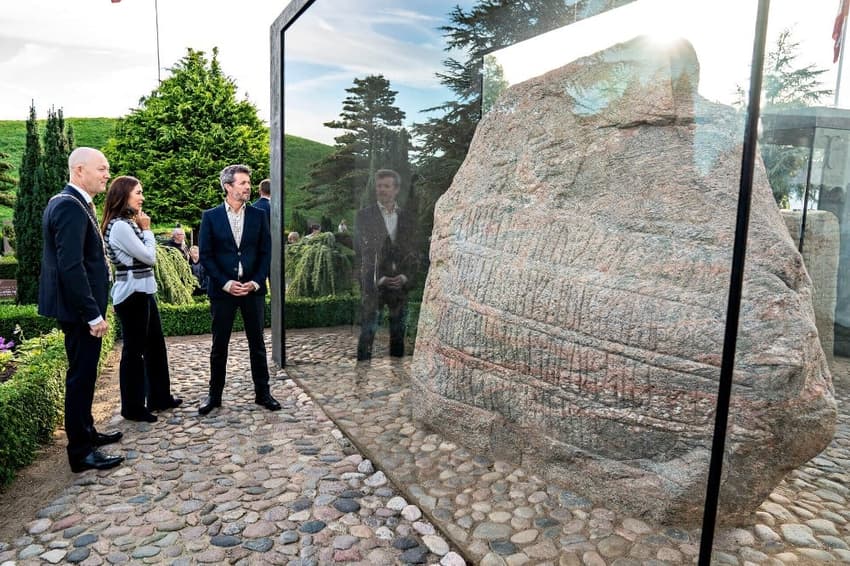Denmark's oldest writing found on 2,000-year-old knife

Archaeologists in Denmark have found a
small knife inscribed with runic letters dating back almost 2,000 years, the
oldest trace of writing found in the country, Museum Odense said on
Tuesday.
Runic letters, called runes, are the oldest alphabet known in Scandinavia.
They were in use from the first or second century AD in northern Europe until being replaced by the Latin alphabet amid christianisation in the 10th century.
"The knife itself is not remarkable but on the blade there are five runes -- which is extraordinary in itself -- but the age of the runes is even more extraordinary because they actually are the oldest we have from Denmark," archaeologist Jakob Bonde told AFP.
"We don't have any writing before this," he said.
Dating back to around 150 years AD, the iron knife was found in a grave in a small cemetery east of Odense, in central Denmark.
The five runic letters spell out the word "hirila", which in the Proto-Norse language spoken at the time means "small sword".
The inscription is a "note from the past", Bonde said.
"It gives us the opportunity to look more into how the oldest known language in Scandinavia developed ... (and) how people interacted with each other."
Bonde said "the person who owned it wanted to show he was, or wanted to be, some kind of warrior."
The first traces of human settlements in what is now Denmark date back to the Stone Age, around 4,000 BC, but there are no traces of any writing before the Roman Iron Age (0 to 400 AD).
A small comb made of bone discovered in 1865 and inscribed with runes dates back to around the same period as the knife, Bonde said.
When writing first appeared in Scandinavia, it was "only small inscriptions, mainly on objects."
"We don't have books for example, or bigger inscriptions."
Denmark's most famous runestones, erected in the 10th century in the town of Jelling, have longer inscriptions.
Strongly identified with the creation of Denmark as a nation state, they were raised by Harald Bluetooth, in honour of his parents King Gorm and Queen Thyra.
Comments
See Also
Runic letters, called runes, are the oldest alphabet known in Scandinavia.
They were in use from the first or second century AD in northern Europe until being replaced by the Latin alphabet amid christianisation in the 10th century.
"The knife itself is not remarkable but on the blade there are five runes -- which is extraordinary in itself -- but the age of the runes is even more extraordinary because they actually are the oldest we have from Denmark," archaeologist Jakob Bonde told AFP.
"We don't have any writing before this," he said.
Dating back to around 150 years AD, the iron knife was found in a grave in a small cemetery east of Odense, in central Denmark.
The five runic letters spell out the word "hirila", which in the Proto-Norse language spoken at the time means "small sword".
The inscription is a "note from the past", Bonde said.
"It gives us the opportunity to look more into how the oldest known language in Scandinavia developed ... (and) how people interacted with each other."
Bonde said "the person who owned it wanted to show he was, or wanted to be, some kind of warrior."
The first traces of human settlements in what is now Denmark date back to the Stone Age, around 4,000 BC, but there are no traces of any writing before the Roman Iron Age (0 to 400 AD).
A small comb made of bone discovered in 1865 and inscribed with runes dates back to around the same period as the knife, Bonde said.
When writing first appeared in Scandinavia, it was "only small inscriptions, mainly on objects."
"We don't have books for example, or bigger inscriptions."
Denmark's most famous runestones, erected in the 10th century in the town of Jelling, have longer inscriptions.
Strongly identified with the creation of Denmark as a nation state, they were raised by Harald Bluetooth, in honour of his parents King Gorm and Queen Thyra.
Join the conversation in our comments section below. Share your own views and experience and if you have a question or suggestion for our journalists then email us at [email protected].
Please keep comments civil, constructive and on topic – and make sure to read our terms of use before getting involved.
Please log in here to leave a comment.